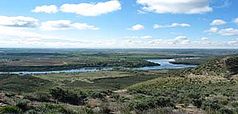Hagerman Fossil Beds National Monument
| Hagerman Fossil Beds National Monument | ||
|---|---|---|
| The Snake River in the sanctuary | ||
|
|
||
| Location: | Idaho , United States | |
| Specialty: | Fossil deposit from the Pliocene | |
| Next city: | Hagerman | |
| Surface: | 17.6 km² | |
| Founding: | November 18, 1988 | |
| Visitors: | 25875 (2006) | |
Hagerman Fossil Beds National Monument is a protected area by the type of National Monuments in the southern US state of Idaho . It is located in the Snake River Plain on the banks of the Snake River and preserves a fossil deposit from the Pliocene era , about 3.5 million years ago. The most important fossil in the area is the Hagerman horse ( Plesippus shoshonensis , originally Equus simplicidens ).
The reserve was established in 1988 and is administered by the National Park Service .

description
In the 19th century, the Oregon Trail , on which early settlers reached the Pacific Northwest via the Rocky Mountains , ran along the Snake River and through the area that is now the National Monument. The fossils are stored in the up to 200 m high terrace of the Snake River.
The first excavations in the area took place in 1929 and were carried out by the Smithsonian Institution . A local rancher had made scientists aware of finds on his land. The excavations produced finds of 140 fossil species, of which 44 were first discoveries and eight species have only been found in Hagerman Fossil Beds.
The protected area was established in 1988 on the west bank of the river, which is the slope in this section , which is why the best finds were made here. In 1997, as part of an emergency excavation financed by sponsors because of the threat of landslides, further findings were made about the shape of the region 3.5 million years ago. The horses did not die where they were found today, but were transported by the slow current of a wide, shallow river and deposited in the current find situation.
The visitor center with an exhibition on the history of the area and the fossil finds is located on the other bank of the river in Hagerman . It also contains a small presentation about the history of the internment of Japanese-born Americans in World War II, because Hagerman Fossil Beds National Monument also looks after the Minidoka National Historic Site , which is about 60 km away , as long as this memorial does not have its own facilities.



